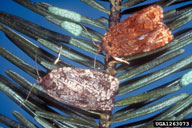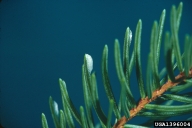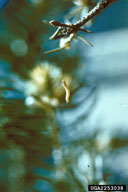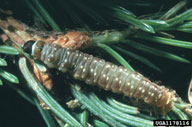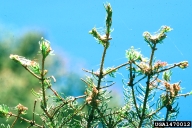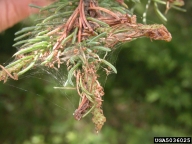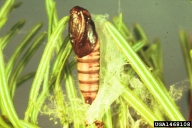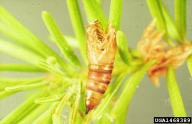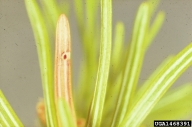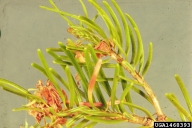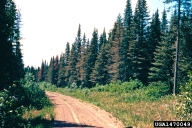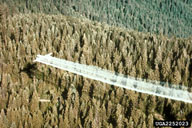Spruce budworm
Choristoneura fumiferana (Clemens) (Lepidoptera: Tortricidae)
Orientation to pest
Spruce budworm, Choristoneura fumiferana (Clemens), is a native North American moth whose larvae feed on balasam fir (Abies balsamea [L.Mill.), white (Picea glauca [Moench] Voss), red (Picea rubens Sarg.), and black spruce (Picea mariana [Mill.] Britton, Sterns & Poggenburg), and sometimes larch (Larix), pine (Pinus), and hemlock (Tsuga). Adults fly in summer and deposits masses of eggs (2-60) on needles in the periphery of the host tree's crown. Eggs hatch and produce larvae that create a hibernacula in which they overwinter as second instars. Hibernaculae are found on branches and other sites on or near the host tree. In the spring of the following year, larvae emerge at or before bud break, disperse aerially, and begin to feed. Buds of staminate flowers are eaten if available, and then old needles are consumed. Larvae then feed on the new vegetative buds, and later, the new foliage. When about half grown, larvae tie several branch tips together with silk to make a nest, where mature larvae later pupate. Females deposit eggs before flying to new sites. Defoliation events from this moth occur regularly over wide areas in eastern Canada and economic losses can be great if uncontrolled. The population dynamics of this species have been the focus of extensive and intense investigation for many decades. For a general review of economic losses and population dynamics see Van Driesche et al. (1996) under articles below.
Hosts commonly attacked
Balsam fir (Abies balsamea [L.Mill.)is the preferred host of this species, but it also feeds on white (Picea glauca [Moench] Voss), red (Picea rubens Sarg.), and black spruce (Picea mariana [Mill.] Britton, Sterns & Poggenburg), as well as to some degree on species of larch (Larix), pine (Pinus), and hemlock (Tsuga).
Distribution
This moth is found throughout the rang of its main hosts (balsam fir and white spruce) from Virginia to Labrador and west to Alaska. Related budworms are found in the western part of North America that were formerly thought to be the same species but now are considered distinct species. Damage in the United States is concentrated along the northern tier of states in the eastern half of the country, from Maine to Minnesota.
Images of spruce budworm
| Figure 1. Adults of spruce budworm, Choristoneura fumiferana | Figure 2. Eggs made of spruce budworm on needle | Figure 3. Young larva hanging from thread preparing for dispersal by wind |
| Figure 4. Mature larva of spruce budworm | Figure 5. Nests of mature spruce budworm larvae | |
| Figure 6. Pupa of spruce budworm (left) and cast pupal skin (right). | Figure 7. Needle mining damage caused by young larva of spruce budworm | |
| Figure 8. Needle feeding damage caused by older larvae of spruce budworm | Figure 9. Damage to stand of host trees by spruce budworms (browning) | Figure 10. Aerial pesticide applications to large areas damaged by spruce budworm |
Important biological control agents related to this pest species
More than 90 species of parasitoids are known to attack spruce budworm in Canada. In Van Driesche et al. (1996) there are details about some of these species and references to their life histories. In addition, some predator groups (birds) are believed to be important to the population dynamics of spruce budworm. While some 15 species of pathogens attack spruce budworm, none are important in the natural population dynamics of the pest. However, one species, Bacillus thuringiensis Berliner, is applied as a biopesticide for areawide control, having fewer nontarget impacts on native species that conventional pesticides. Hypotheses concerning the causes driving changes in spruce budworm numbers are discussed in Van Driesche et al. (1996). It is widely believed that one important influence is variation in spring weather that leads to different degrees of synchrony between spring larval emergence and bud break of host trees, with late bud break being unfavorable.
Web links for information on spruce budworm
- Forest Insect & Disease Leaflet 160 | USDA Forest Service
- Wikipedia Article | Wikipedia, the free encyclopedia
- Sampling Methods | Virginia Tech
Links to other documents related to sampling spruce budworm in various contexts - Fact Sheet | E.H. Strickland Entomological Museum, University of Alberta
Contains information on taxonomy of this species - Fact Sheet | Natural Resources Canada
Articles
- Van Driesche, R.G., S. Healy, and R. C. Reardon. 1996. Biological Control of Arthropod Pests of the Northeastern and North Central Forests in the United States: A review and recommendation. FHTET 96-19, December 1996, USDA Forest Service, Morgantown, see: http://www.forestpestbiocontrol.info/fact_sheets/documents/arthropodpestsnortheastern_northcentral.pdf.
